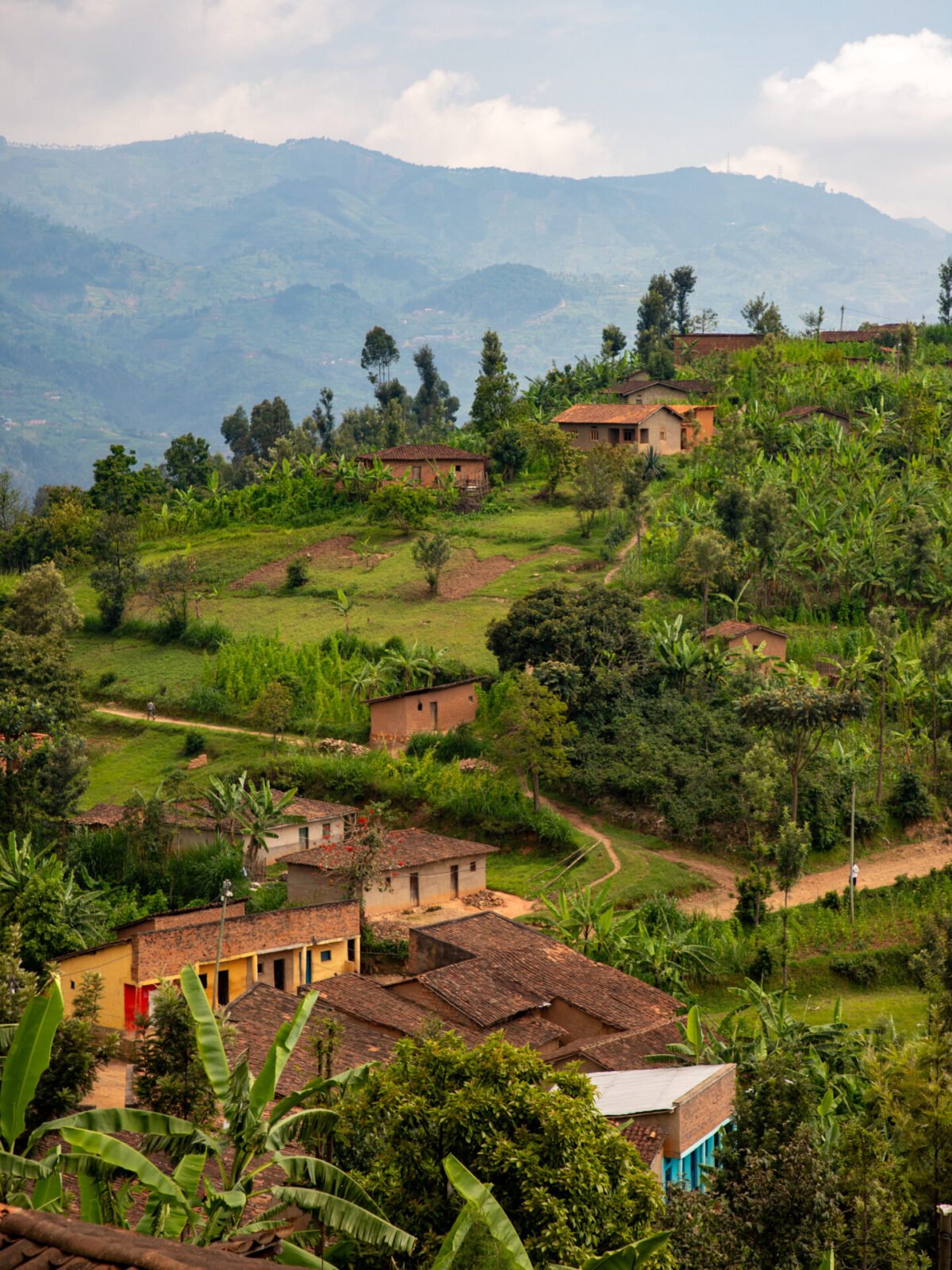
Last Updated on 19 August 2025
Known as the Land of a Thousand Hills, Rwanda is one of Africa’s most captivating destinations— rich in natural beauty and extraordinary wildlife, with a national story powerfully rewritten after unthinkable tragedy. Today, the country is re-emerging not only as a conservation success, but also as a cultural and creative centre. Where lush tea plantations give way to misty mountains and crater lakes shimmer beneath volcanic peaks, this land is best explored on a thrilling road trip!
This 10-day Rwanda itinerary takes you deep into one of the most incredible African countries, combining bucket-list experiences like gorilla trekking in Volcanoes National Park and chimpanzee tracking in Nyungwe National Park with time to relax on Lake Kivu’s peaceful shores and explore the vibrant culture of Kigali, one of Africa’s safest and most forward-thinking capitals. It’s the perfect self-drive adventure through a country that will surprise, inspire, and stay with you long after you’ve left!
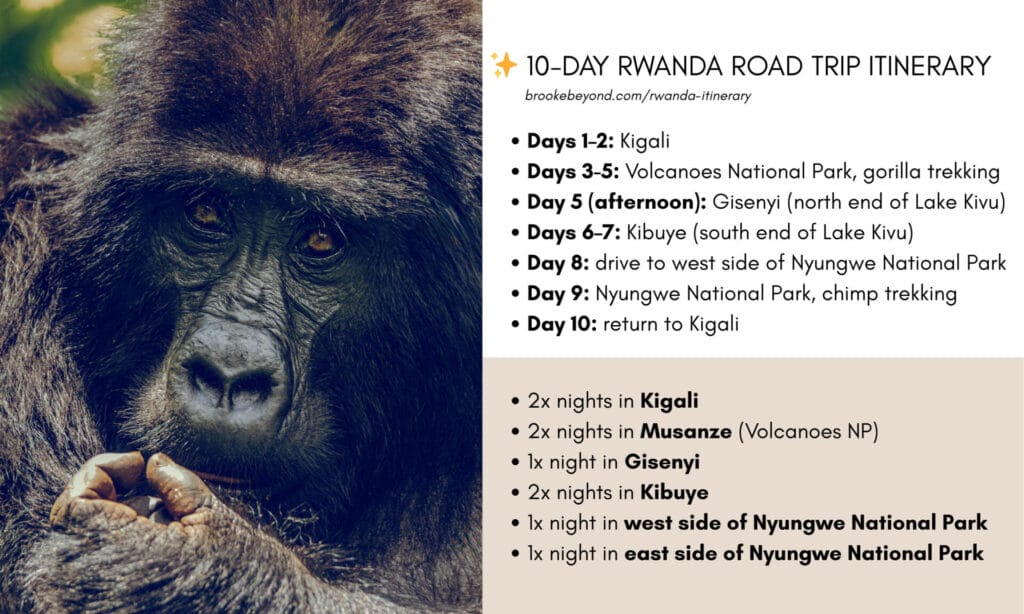
Itinerary map
Here’s an overview map of my proposed 10-day road trip through Rwanda. Keep reading for trip logistics and a detailed day-by day itinerary that will take you from Kigali to Lake Kivu and 2 incredible national parks!
Rwanda road trip logistics
When to go
Rwanda is a year-round destination, but the best time to visit is during one of the dry seasons:
- Mid-December to February: best for gorilla and chimpanzee trekking; drier forest trails, fewer afternoon storms, and sunny days
- March–May & October–mid-December: rainy seasons; expect muddy trails, occasional road washouts, and limited visibility—but this is also the low season with fewer tourists and more availability for permits and accommodation
- June to September: another dry season, ideal for wildlife viewing and hiking with lower humidity and clear skies
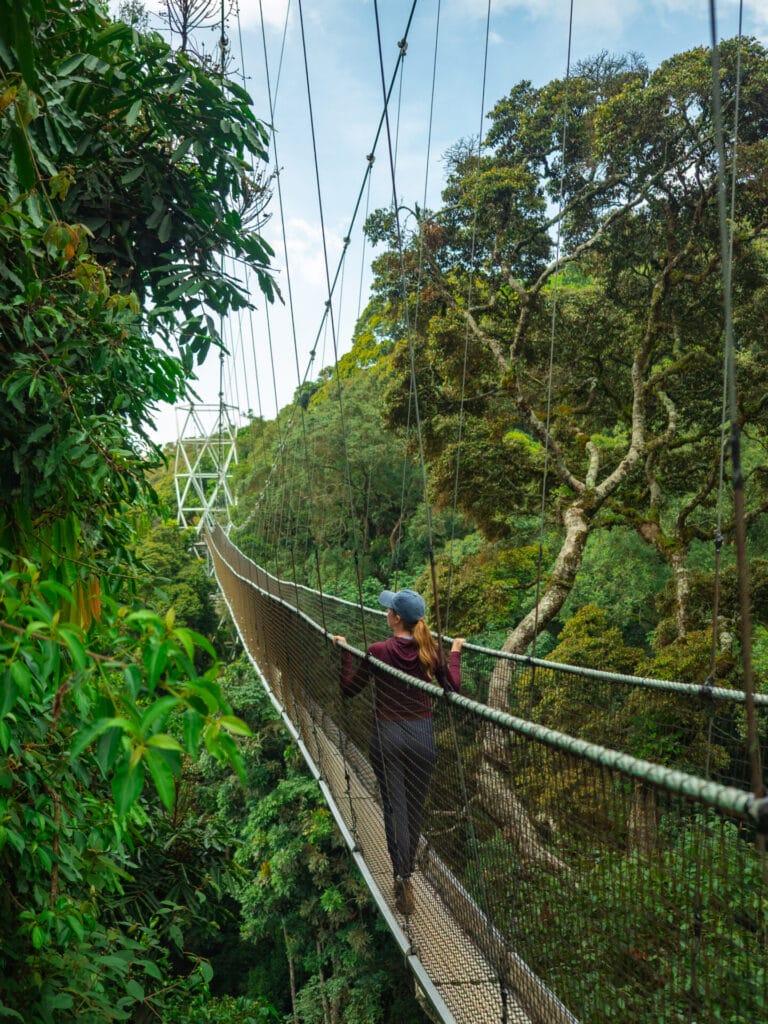
Getting there
This itinerary is designed as a loop, beginning and ending in Kigali, Rwanda’s vibrant capital city. To begin this road trip, fly into Kigali International Airport (KGL), the only international airport in the country.
Getting around
This itinerary is designed as a self-drive road trip through Rwanda— distances are modest (2-4hrs per day), roads are generally in excellent condition, and outside of Kigali, there’s very little traffic on the roads. All in all, we found Rwanda to be a straightforward, safe, and comfortable place to drive ourselves!
There are very few international rental companies operating in Rwanda (Europcar, Avis) and rates can be steep, so a better option is to rent through a local company, where older but reliable 4WD vehicles typically cost $30–60/day with delivery right to your hotel in Kigali. We hired a Toyota RAV4 through Kigali Car Rentals and found it to be the perfect setup for this route!
I recommend booking your car to be delivered to your hotel in Kigali around midday on day 3 of the itinerary— it’s stressful to drive in the city and cheap mototaxis are everywhere, so save yourself money/hassle and only hire a car for 7 days of this 10-day itinerary.
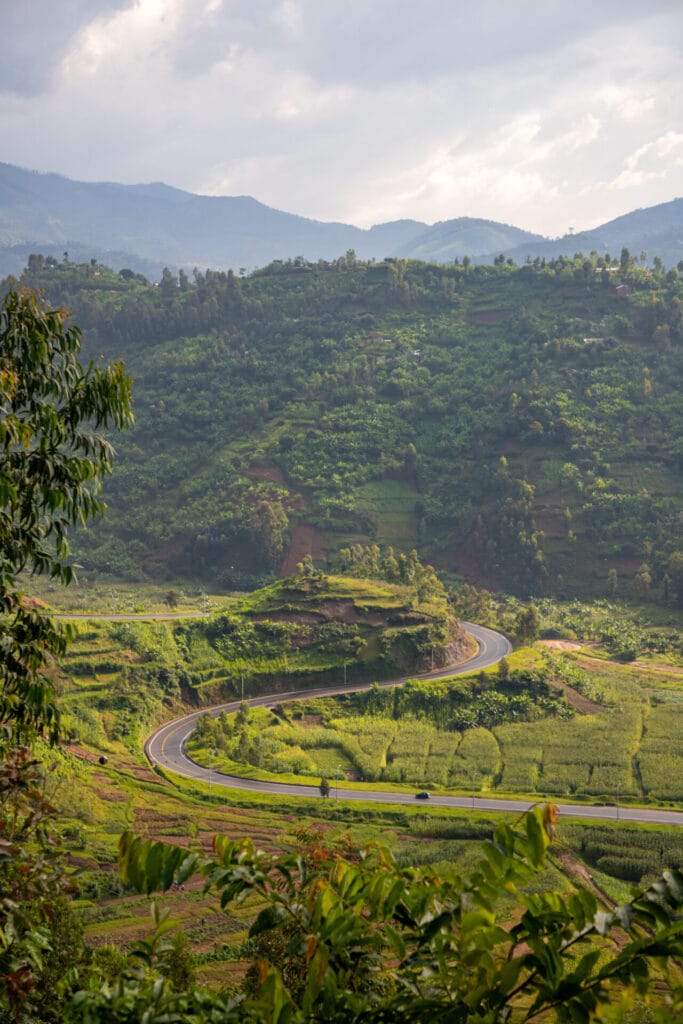
Tips for driving in Rwanda
- The major highways connecting Kigali to Volcanoes National Park, Lake Kivu, and Nyungwe National Park are all in excellent condition, but it’s still recommended to rent an SUV for comfort on rural roads that are part of this itinerary.
- The maximum speed limit across Rwanda is 80km/hr, which seems laughably slow for a rural highway with no traffic— until you see how insanely windy the roads are and how many local villagers walk right alongside the non-existent shoulder. Going slow is a necessary part of driving in Rwanda and there are plentiful speed cameras to enforce limits.
- It bears repeating that there’s a LOT of foot-traffic on the side of the highway throughout the entire country. Locals use these roads to walk between fields, carry produce to markets on the weekends, or simply to move between villages without a car. It’s not advised to drive at night because it’s so hard to see people on the roads, but even in daylight, be super cautious coming around corners.
- Even in our old RAV4, we got quite a bit of attention from the locals as we drove through Rwanda— people would stop to stare at us and, if we pulled over to take photos, we’d quickly amass a gaggle of curious local children AND adults. Although it did sometimes come with requests for money, this attention was always friendly, so smile and wave!
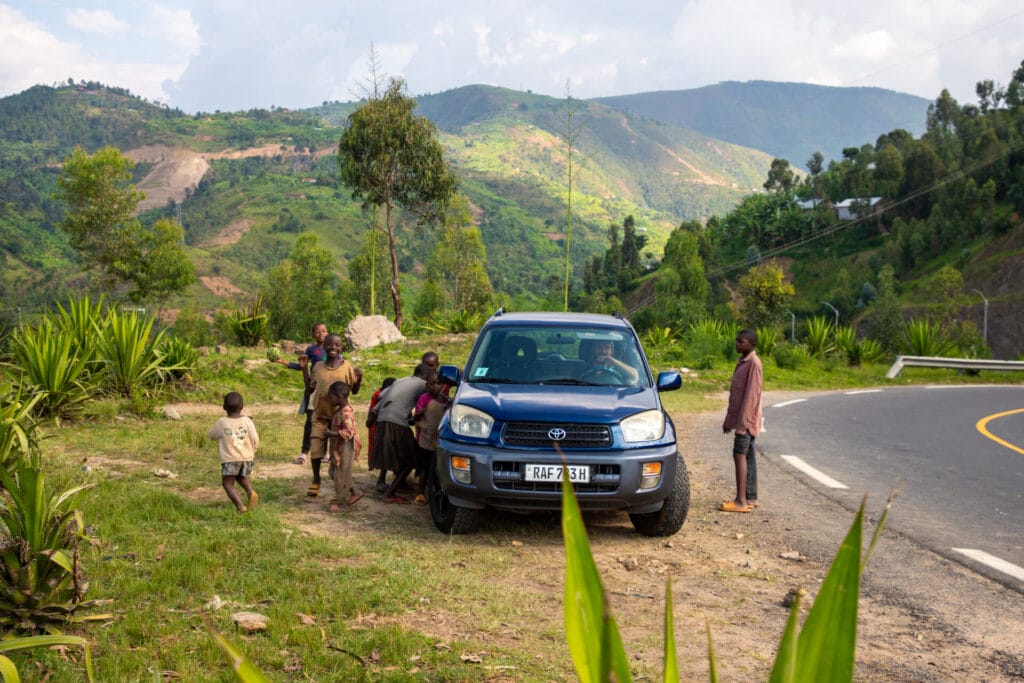
Where to stay
This itinerary features a mix of comfortable city hotels, boutique lakefront stays, and rustic national park lodging; some destinations (like Kigali and Musanze) have plentiful options to suit every budget, while rural accommodations near Nyungwe are pretty much all that works with this itinerary! On a modest budget, I’d specifically recommend booking the following:
- Kigali (2 nights): Coalescence Hotel Rwanda (budget rooms with shared kitchen) or Eagle View Lodge (mid-range, spectacular view over the city) or Hotel des Mille Collines (high-end, historic property used as a refuge during the genocide)
- Musanze (2 nights): Volcano View (budget) or Amikus Hotel (mid-range, right in town) or La Locanda (mid-range lodge, includes breakfast + dinner)
- Gisenyi (1 night): Paradise Malahide (mid-range waterfront lodge) or Ubucuti Lodge (luxury lodge with lake views)
- Kibuye (2 nights): Cormoran Lodge (breathtaking waterfront cabins)
- west side of Nyungwe National Park (1 night): EAR Ken Barham Guesthouse (comfortable community guesthouse)
- east side of Nyungwe National Park (1 night): Kitabi Eco Centre (cabins with amazing view of the forest)
🗺️ TRAVEL TIPS FOR RWANDA
→ Language: Kinyarwanda, but French is widely spoken by older generations and English is widely spoken by younger generations; language barrier is minimal for English-speakers
→ Currency: Rwandan Franc (RWF), approximately 10,000RWF = $7USD as of May 2025
→ Tourist visa: 30-day tourist visa on arrival for all nationalities ($50 USD); also consider the East Africa Tourist Visa ($100) if visiting Uganda or Kenya
→ SIM card: install an eSIM for Rwanda via Airalo; service limited in the national parks & other rural areas
→ Gorilla trekking permits: $1,500USD per person including Volcanoes National Park entry; book well in advance through a tour operator (recommended) or directly via Rwanda Development Board
→ Chimpanzee trekking permits: $150USD permit + $100 entry fee for Nyungwe National Park; book anytime by emailing nyungwe@africanparks.org
→ Essential apps: Yego (ride-hailing app for mototaxis, widely used in Kigali); MoMo (cashless payments app, accepted more than credit cards across Rwanda); Google Maps (download for offline use)
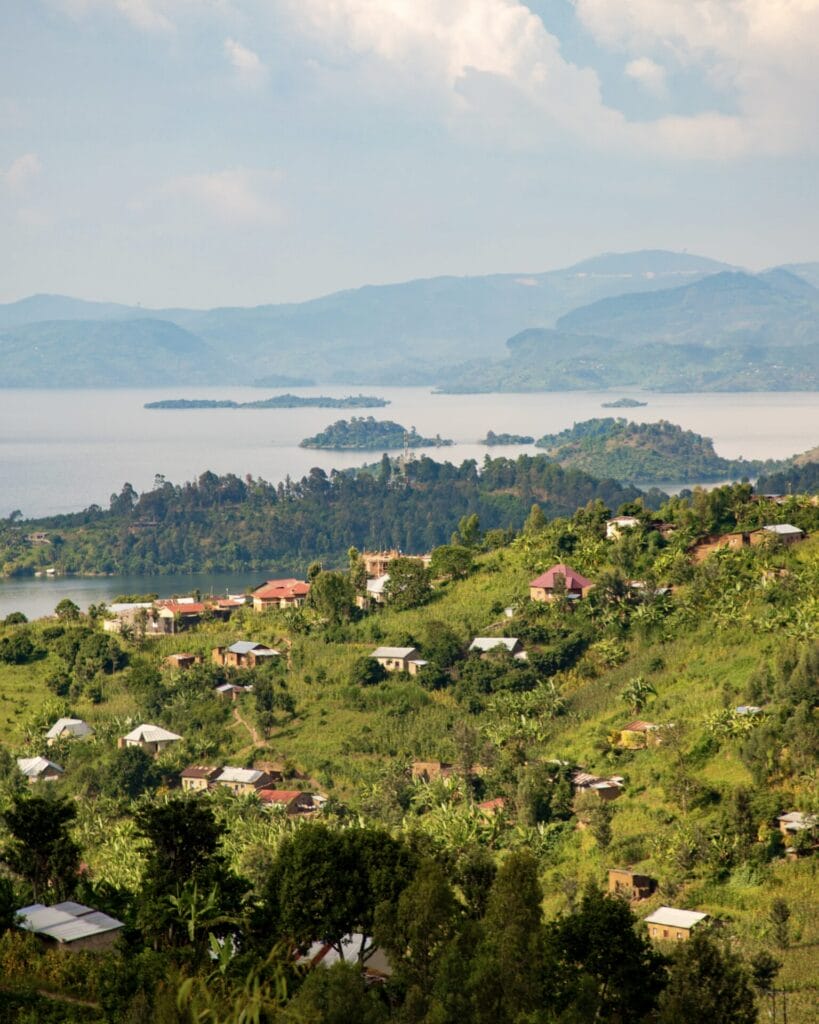
*10-day Rwanda road trip itinerary
- Days 1–2: Kigali
- Days 3-5: Volcanoes National Park (Mt Bisoke & gorilla trekking)
- Day 5 (afternoon): drive to Gisenyi (north end of Lake Kivu)
- Days 6–7: Kibuye (south end of Lake Kivu)
- Day 8: drive to west side of Nyungwe National Park
- Day 9: Nyungwe National Park (chimpanzee trekking & canopy walk)
- Day 10: return to Kigali
Days 1–2: Kigali
Set among the rolling green hills that characterise this small East African country, Kigali is many things: a thriving centre of arts and culture, a living monument to resiliency and forgiveness, a touch chaotic… and also incredibly charming. Rwanda’s vibrant capital city is the perfect place to begin this itinerary— not just for logistical reasons, but for the opportunity to gain vital cultural and historical context.
Just three decades after a horrific genocide that claimed nearly one million lives and more than 10% of the population, Kigali has risen from the ashes as one of Africa’s most dynamic, culturally rich, and forward-thinking cities. Today, it’s a hub for innovation, sustainability, and social progress, offering travellers a chance to connect with Rwanda’s past while witnessing its bold vision for the future.



What to do in Kigali
Kigali is an enchanting mix of chaos and culture, with a thriving arts and music scene, spectacular cuisine, and an unshakeable community spirit. We spent 4 days here and barely scratched the surface, but with 2 days, here’s what we’d most recommend:
- Kigali Genocide Memorial: a moving and essential tribute to the victims of the 1994 genocide, offering education and reflection on Rwanda’s path to reconciliation; entrance is free, but we’d highly recommend the 20,000RWF ($14 USD) audio tour, which also helps support the memorial
- Nyamirambo Women’s Centre: a fantastic organisation directly responsible for creating hundreds of jobs and providing training for thousands of women in Kigali, empowering them to support their families; visit the storefront in Nyamirambo to shop high-quality handicrafts made by women in the community
- Nyamirambo District Walking Tour: run by the Nyamirambo Women’s Center, this community-led tour explores one of Kigali’s liveliest neighbourhoods through the lens of local women; the 2.5hr walking tours cost 20,000RWF ($14USD) + 5,000RWF ($3.5USD) for lunch in a local home, which is a great way to try local cuisine, support this awesome organisation, AND get a delicious lunch for a bargain
- Biryogo Free Zone: Rwanda’s first car-free district, now a buzzing local hub filled with tea houses, food vendors, and vibrant street life
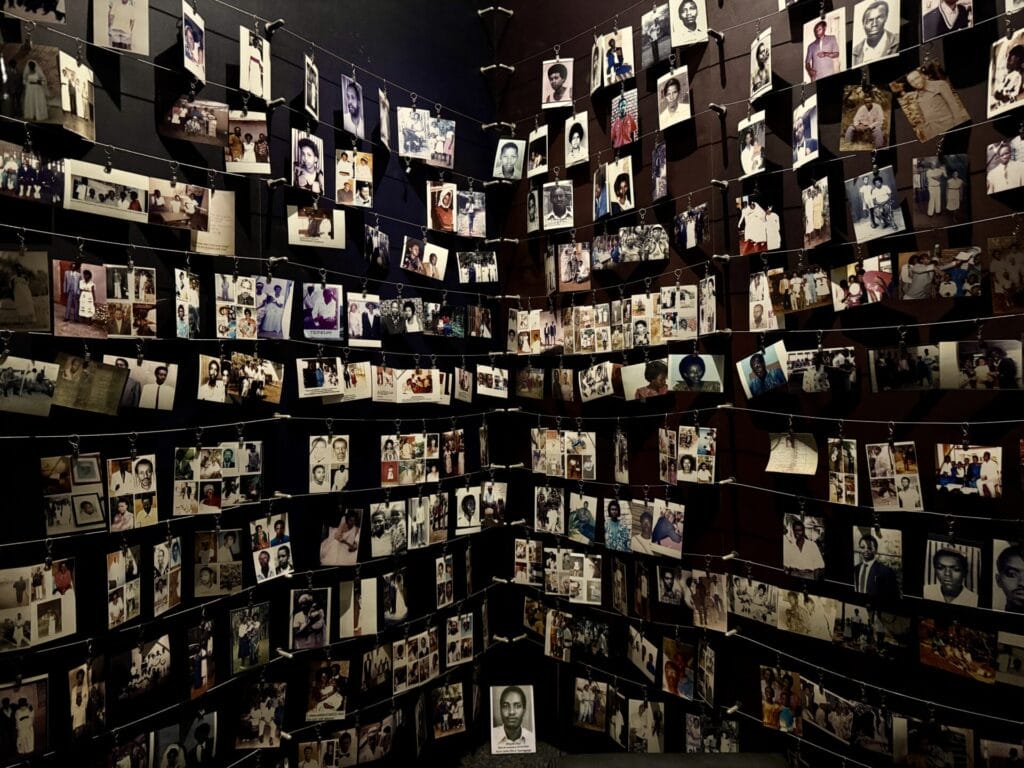


Where to eat in Kigali
In so many parts of the world, Rwanda included, food is synonymous with culture and tradition. Don’t miss the opportunity to experience Kigali through the lens of some of its best food:
- Meza Malonga: this small, stylish restaurant from Chef Dieuveil Malonga serves up Michelin-star-worthy food with African flavours sourced from across the continent; the 10-course tasting menu (100,000 RWF / $70USD) was easily one of the best meals we’ve had in our entire lives, and we highly recommend adding the wine pairing, which includes 5 hand-selected glasses (bookings essential)
- Repub Lounge: laidback terrace dining with fantastic cocktails and Rwandan-fusion cuisine; get the “group menu” (35,000RWF / $24USD per person) to try multiple local favourites like boulettes (deep-fried meatballs), sambaza (tiny fried fish from Lake Kivu), isombe (cassava leaves with peanut sauce) and brochettes (grilled goat skewers)
- Tamu Tamu – Taste of Rwanda: a low-key spot for traditional Rwandan dishes like isombe, ibihaza, and akabenz, cooked with home-style authenticity
- Khana Khazana: excellent Indian food with generous portions and a leafy garden setting; Rwanda’s Indian community is small but influential, and Kigali’s Indian cuisine punches well above its weight!
- Poivre Noir: fusion fine dining that blends Rwandan ingredients with French technique, perfect for a dinner date in Kigali
- Inzora Rooftop Café: local coffee and creative vegetarian options with excellent views over Kigali’s hills and good wifi!
Where to stay in Kigali
Book 2 nights in Kigali at Coalescence Hotel Rwanda, a stylish and affordable guesthouse in Gacuriro. For a mid-range option with panoramic views, Eagle View Lodge offers a peaceful retreat above the city, while Hotel des Mille Collines provides a historic high-end stay with modern amenities and a pool in central Kigali. All are well-located for exploring the city, with easy access to key attractions and restaurants.
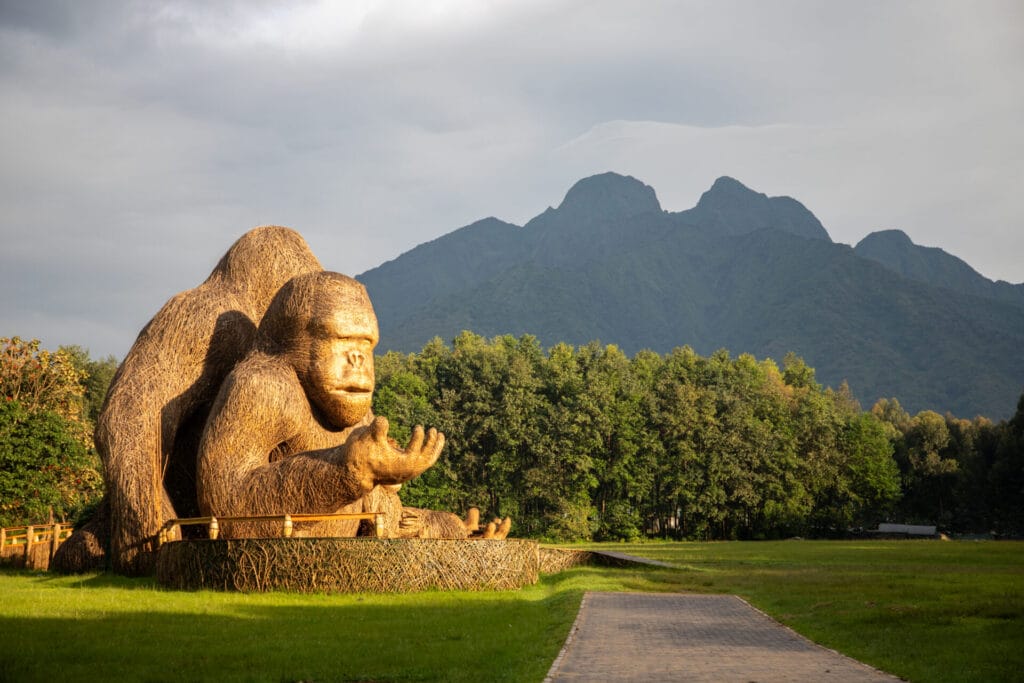
Days 3-5: Volcanoes National Park
The next stop on your Rwanda road trip is the legendary Volcanoes National Park, a misty high-altitude jungle framed by five extinct volcanoes: Mt Bisoke, Mt Karisimbi, Mt Gahinga, Mt Muhabura, and Mt Sabyinyo. This otherworldly landscape of rainforest and bamboo groves is not only Africa’s oldest national park, but also one of the only places on Earth home to a thriving population of mountain gorillas.
Over the next two days, you’ll experience two of Volcanoes’ most iconic adventures: climbing to the crater lake atop Mt Bisoke and spending an hour with a gorilla family, a truly once-in-a-lifetime wildlife encounter.
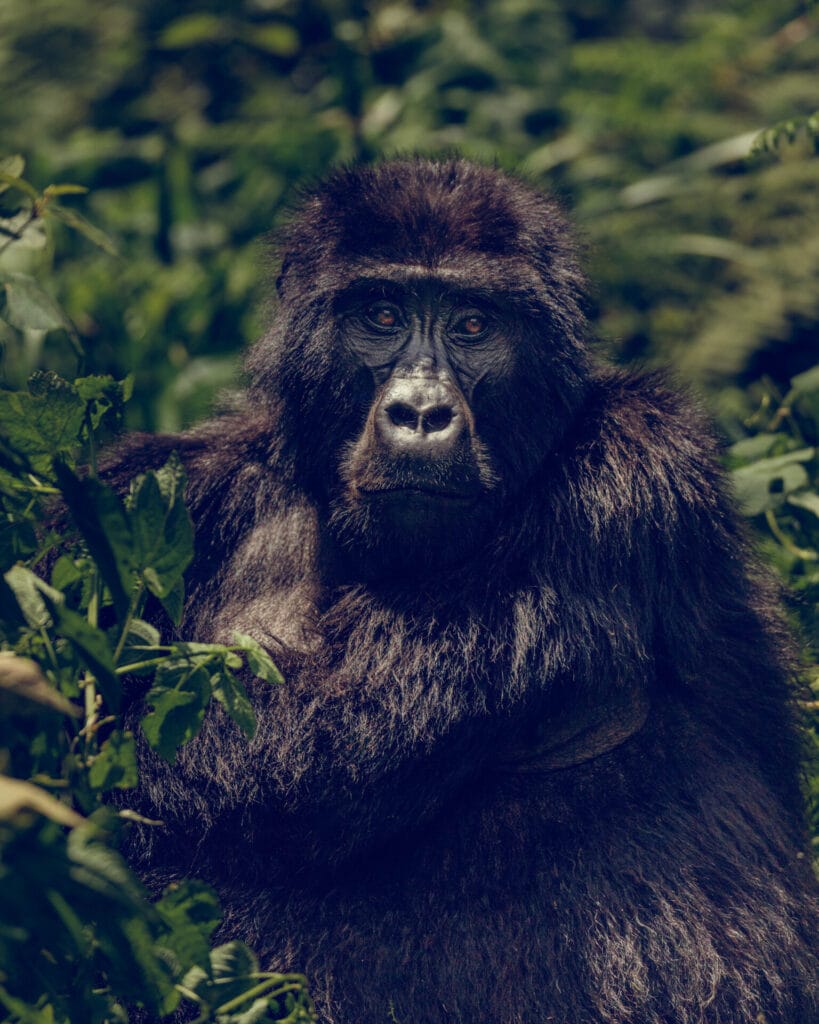
Driving to Volcanoes National Park
On the afternoon of Day 3, organise your rental car to be delivered to your hotel in Kigali— this is standard with most of the local car hire companies (and, as mentioned previously, you do NOT need a car for your first 2 days in Kigali).
Setting off from Kigali, drive 100km and about 2.5hrs to Musanze; formerly Ruhengeri (and still shown as such on some maps), this town is the ideal base for exploring Volcanoes National Park over the next 2 days. It’s about 30min from Musanze to the park headquarters in Kinigi, which you’ll drive to on the morning of Day 4 and Day 5 for activities inside the park.
🚗 TIPS FOR DRIVING IN RWANDA
– The maximum speed limit across Rwanda is 80km/hr and there are frequent speed cameras!
– There’s a LOT of foot-traffic on the side of the highway throughout the entire country, so keep your eyes peeled for pedestrians, especially on winding roads.
– We found Google Maps to be fairly accurate when it comes to driving directions, but usually an underestimate when it comes to driving TIME— budget up to 1.5x what’s quoted on the GPS just to make sure you’re not driving after dark or late for reservations.
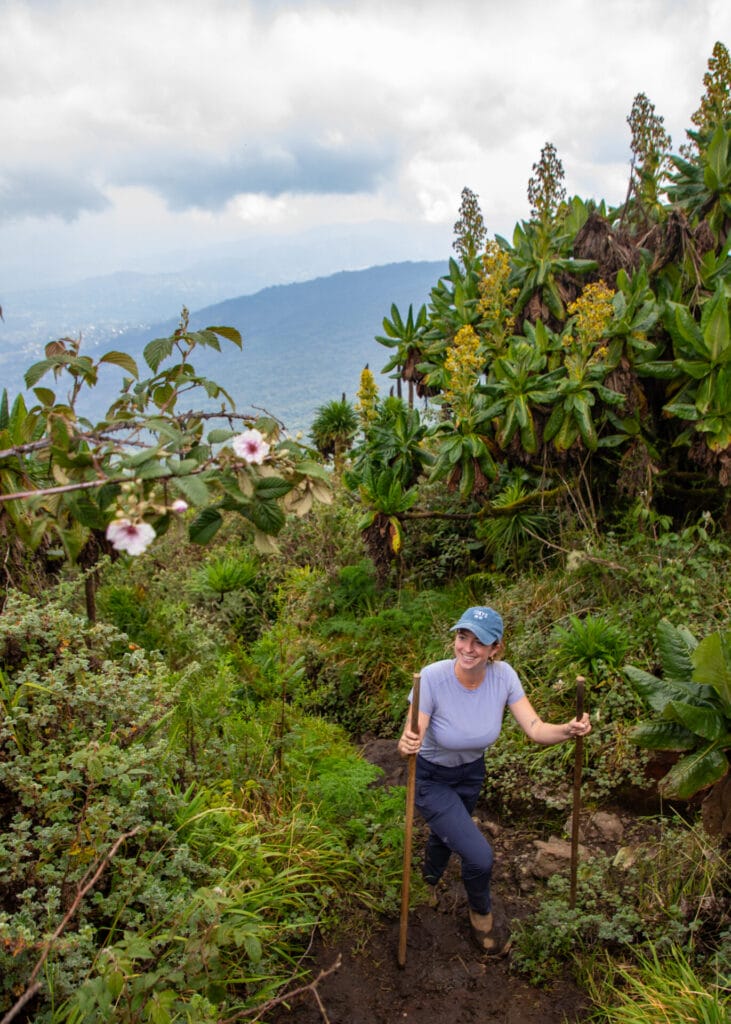
Mt Bisoke Hike in Volcanoes National Park
On Day 4 of this itinerary, we recommend heading into Volcanoes National Park to summit Mt Bisoke, a dramatic 3,711m volcano straddling the border between Rwanda and the DRC. The climb leads through dense jungle and high-elevation rainforest to a beautiful crater lake at the summit, often shrouded in rolling fog for an otherworldly gorillas in the mist feel.
Because this area is home to wild mountain gorillas (!!), you are required to join a guided hike ($75USD per person) led by a ranger and accompanied by armed guards for safety. After meeting at the park headquarters in Kinigi (30min from Musanze) around 8am, the hike itself takes ~6hrs return, including a sustained, muddy 1,000m ascent to the summit— proper footwear and a good level of fitness are essential.
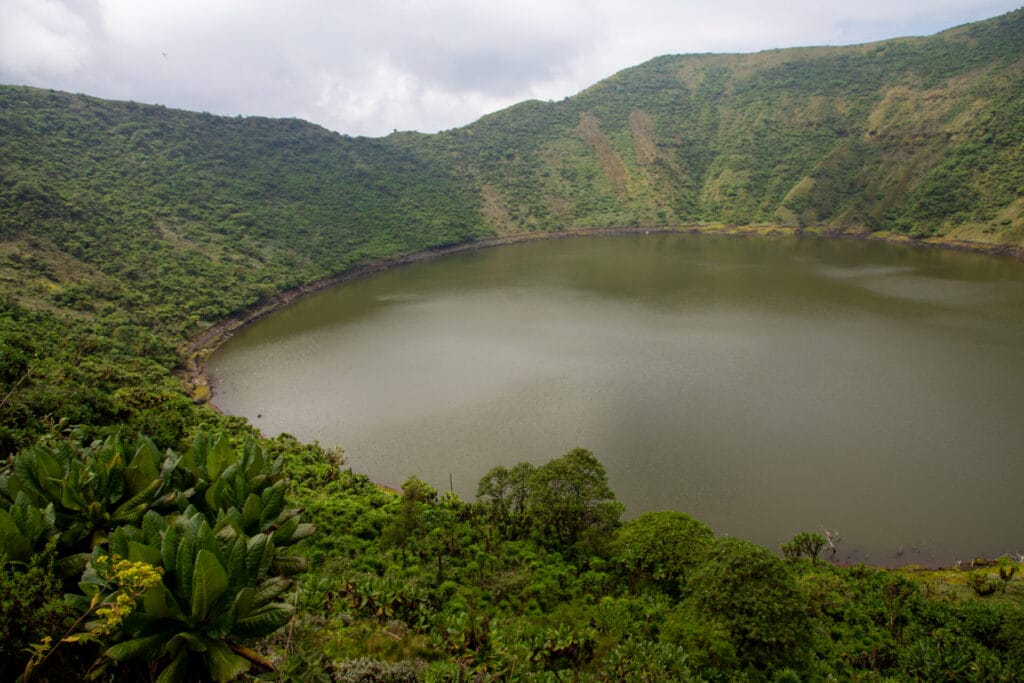
Expect to arrive back at the park headquarters around 4pm, after which you can drive back to your hotel in Musanze (30min) and enjoy a hot shower before dinner!
🌋 AN HONEST REVIEW OF MT BISOKE
I’d be remiss not to mention some of the things we did not like about this hike, primarily that it is INSANELY MUDDY. If it has rained in the past week, the trail turns into a slip-n-slide of thick mud and I had a really difficult time staying upright (to be fair, I was wearing old boots that were polished flat on the bottom).
If you want to do this hike, I strongly recommend avoiding the wet season, wearing hiking boots with excellent tread, and going in with realistic expectations. The reward is a beautiful view, fascinating plantlife, and the opportunity to see wild mountain gorillas in a unique setting!


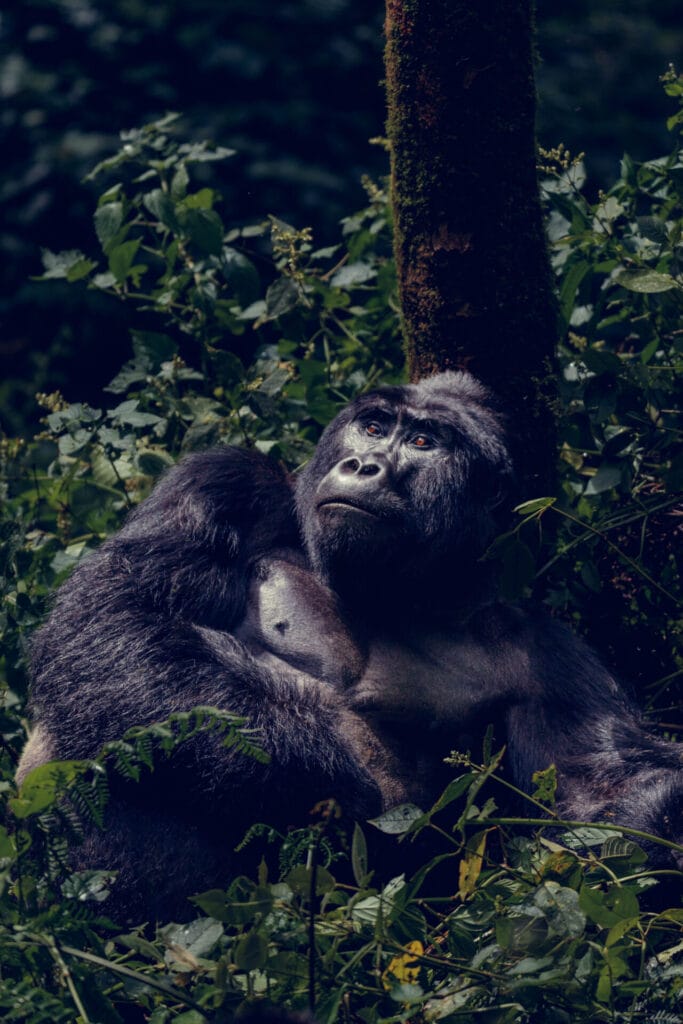
Gorilla trekking in Volcanoes National Park
On Day 5 of this itinerary, return to Volcanoes National Park for one of the most unforgettable wildlife experiences on the planet: trekking to see habituated mountain gorillas in their natural habitat.
Volcanoes is the only park in Rwanda (and one of four worldwide) where you can come face-to-face with these endangered primates deep in the forest. While there’s no shortage of incredible sights on this road trip, this is likely the experience that brought you to Rwanda in the first place— and despite the astronomical $1,500 USD permit fee, it is absolutely worth it! If you value authentic, sustainable wildlife encounters, gorilla trekking will be one of the most meaningful adventures of your life.
- Start time: arrive at Kinigi Park Headquarters around 7am for briefing and group assignment
- Permit cost: $1,500 USD per person, includes ranger guide, trackers, and park access; book well in advance via the Rwanda Development Board
- Trek duration: 1–5hrs each way, depending on gorilla location
- What to bring: rain jacket, sturdy hiking boots, long pants, gaiters or tall socks (for nettles), layers, water, and a camera with no flash



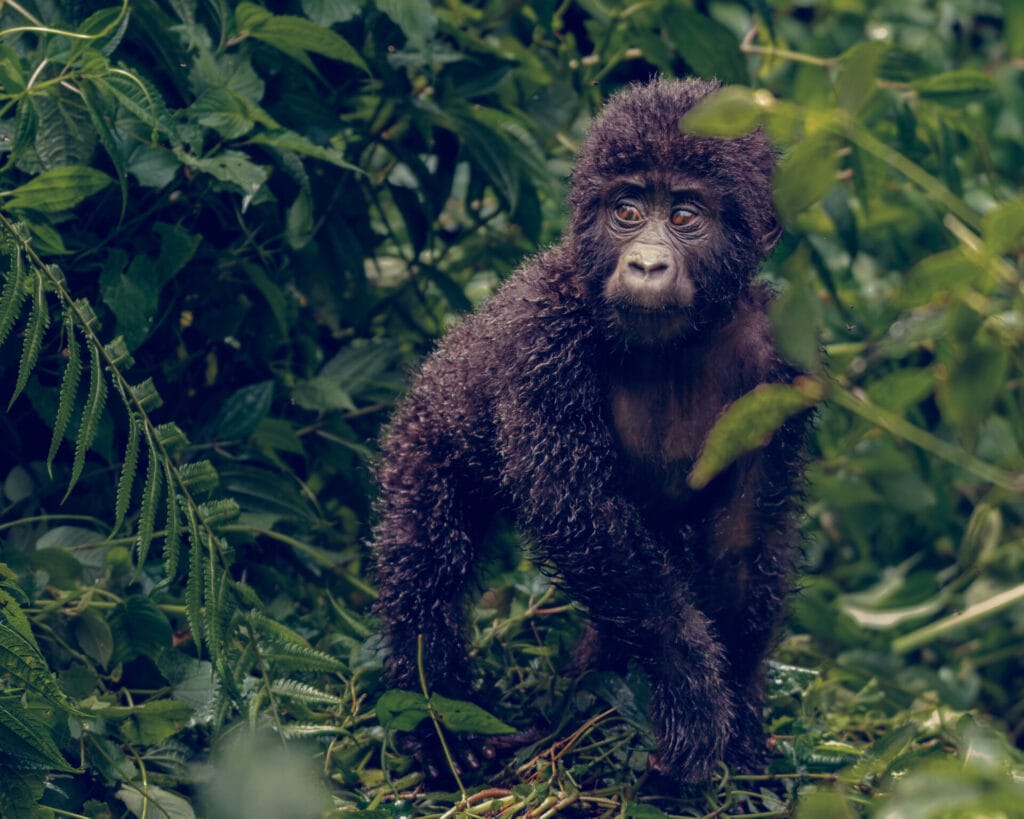
After securing your permit (well in advance), you’ll check in at Park Headquarters for rangers to assign you to a specific gorilla family based on fitness level and preferences. You’ll then set off with a guide, trackers, and a small group of fellow hikers (limited to 8 people per group to minimise impact and protect the gorillas) to find your gorilla family, which can take anywhere from 1-5hrs through steep, muddy, and sometimes dense rainforest.
Once you reach the gorillas, you’ll get to spend a magical 1 hour in their presence, watching them eat, groom, play, and interact in ways that feel profoundly human. I literally cried from wonder— and then James proposed, so it was truly a day we will never forget.
📸 Check out all the camera gear we used for gorilla trekking
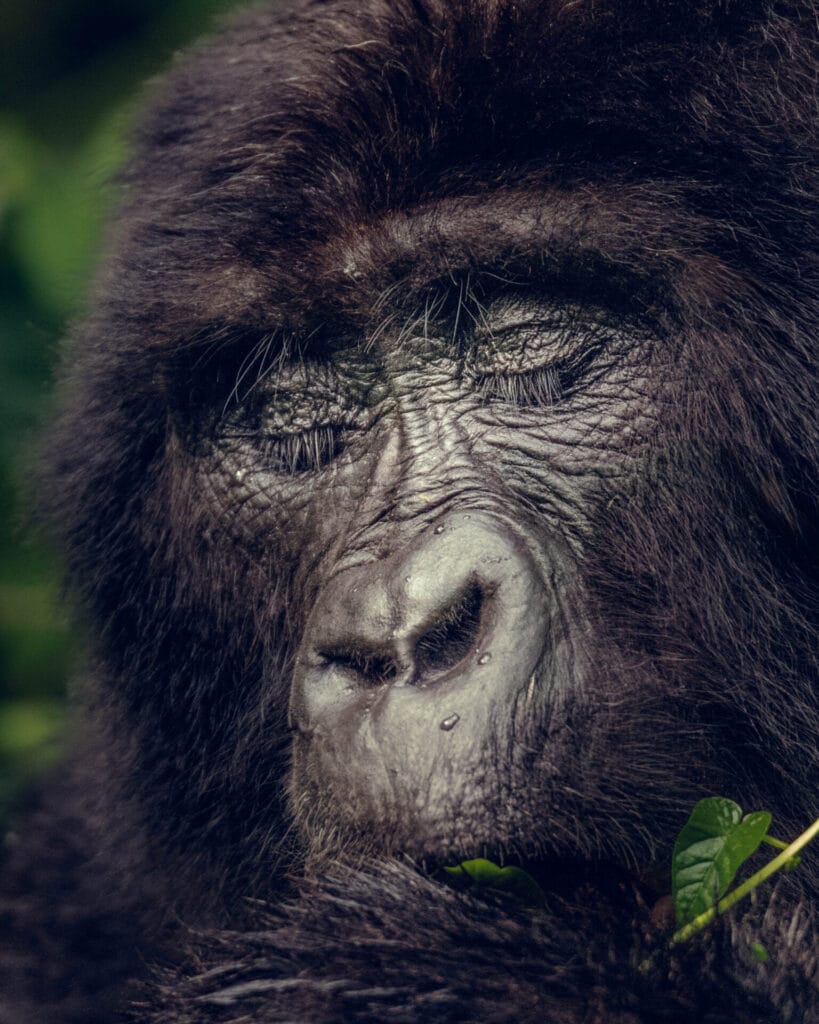
Where to stay near Volcanoes National Park
While exploring Volcanoes National Park, stay 2 nights (Night 3 and 4) in Musanze, about 30min from Park Headquarters in Kinigi. We stayed at Amikus Hotel (mid-range, right in town), but if you’d prefer the security of Booking.com, try Volcano View (budget) or La Locanda (mid-range lodge, includes breakfast + dinner).
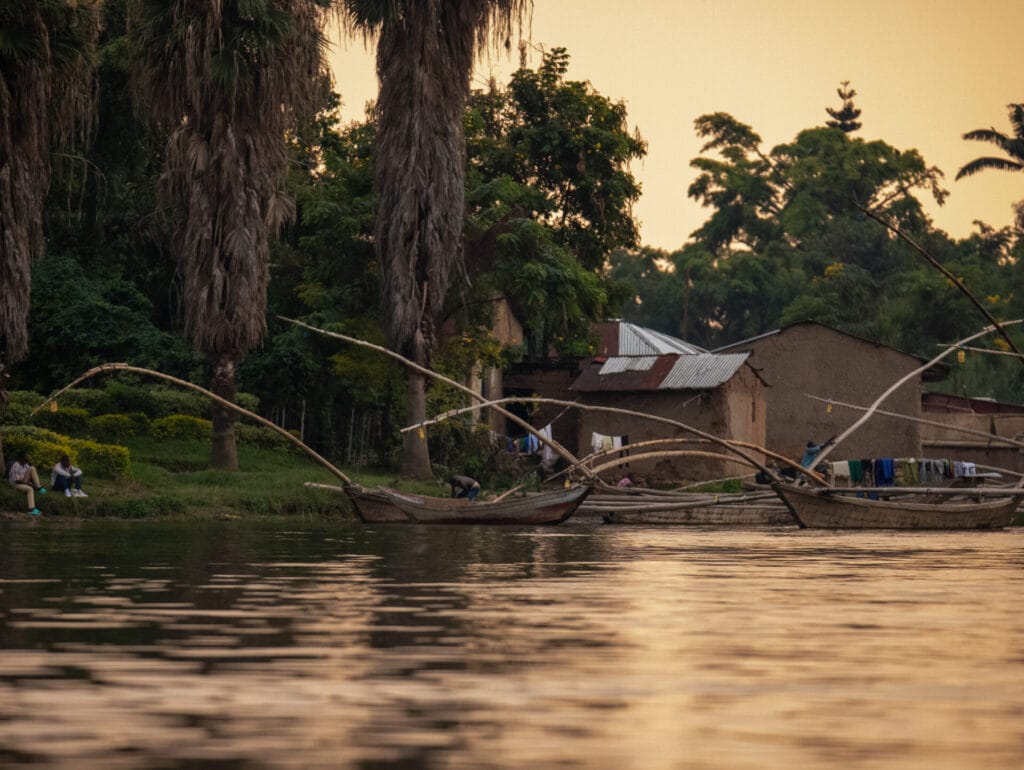
Day 5 (afternoon): Gisenyi
After your gorilla trek on Day 5, continue west to Gisenyi, a laid-back town on the northern shores of Lake Kivu. With its tranquil waterfront, red-roofed villas, and misty views across the Congolese border, Gisenyi offers a perfect contrast to the jungle intensity of Volcanoes National Park.
Getting to Gisenyi
From Volcanoes National Park or Musanze, the drive to Gisenyi is just 70km, but due to winding roads and strict speed limits, expect the journey to take nearly 2hrs.
What to do in Gisenyi
Depending on what time your gorilla trek finishes (which could be anywhere from 11am to 3pm or later), you may have time to squeeze in a sunset boat ride on Lake Kivu, which we’d consider the best thing to do in Gisenyi. If not, save the boat ride for the following morning (Day 6) before getting on the road to Kibuye at the southern end of Lake Kivu.
*We personally spent 2 nights in Gisenyi, and if you have the time, this definitely relaxes things and ensures you have time for a sunset boat ride and a trip to one of the nearby coffee plantations!


Where to stay in Gisenyi
Book 1 night at Paradise Malahide (mid-range waterfront lodge) or Ubucuti Lodge (luxury lodge with lake views). If your schedule allows, consider adding a second night to unwind and fully enjoy this gorgeous spot on Lake Kivu.
As is typical in Rwanda as soon as you get outside the city, Paradise Malahide has an on-site restaurant serving breakfast (included), as well as lunch and dinner (for a reasonable price). There are other options in town, but we found the food to be good and extremely convenient, especially when arriving late.
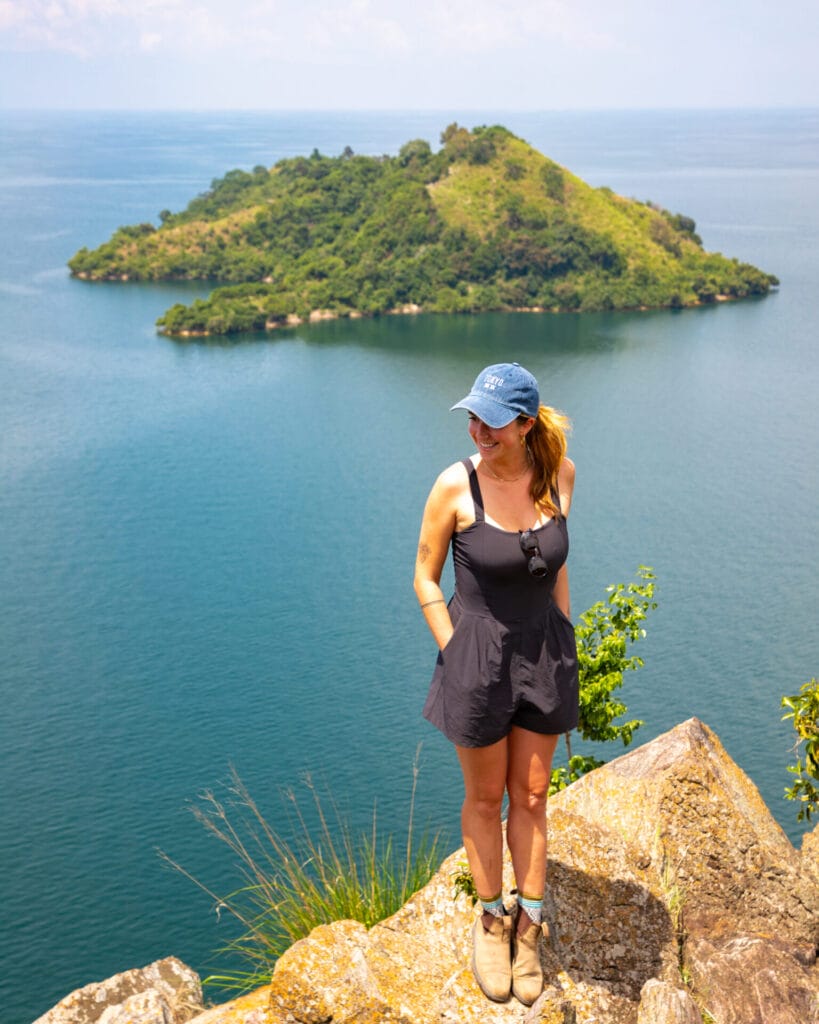
Days 6-7: Kibuye
Continue your journey along the waterfront to Kibuye, a peaceful town on the southern end of Lake Kivu. Surrounded by forested hills and dotted with tiny islands, Kibuye is arguably the most beautiful stop along the lake— and absolutely worth lingering for a couple of days.
Getting to Kibuye
Departing Gisenyi on the afternoon of Day 6, drive 90km south along the winding lakeshore to reach Kibuye. The road is slow-going and packed with switchbacks, so expect the drive to take about 2.5hrs, not including the countless photo stops you’ll want to make— this might be the most scenic drive in all of Rwanda!
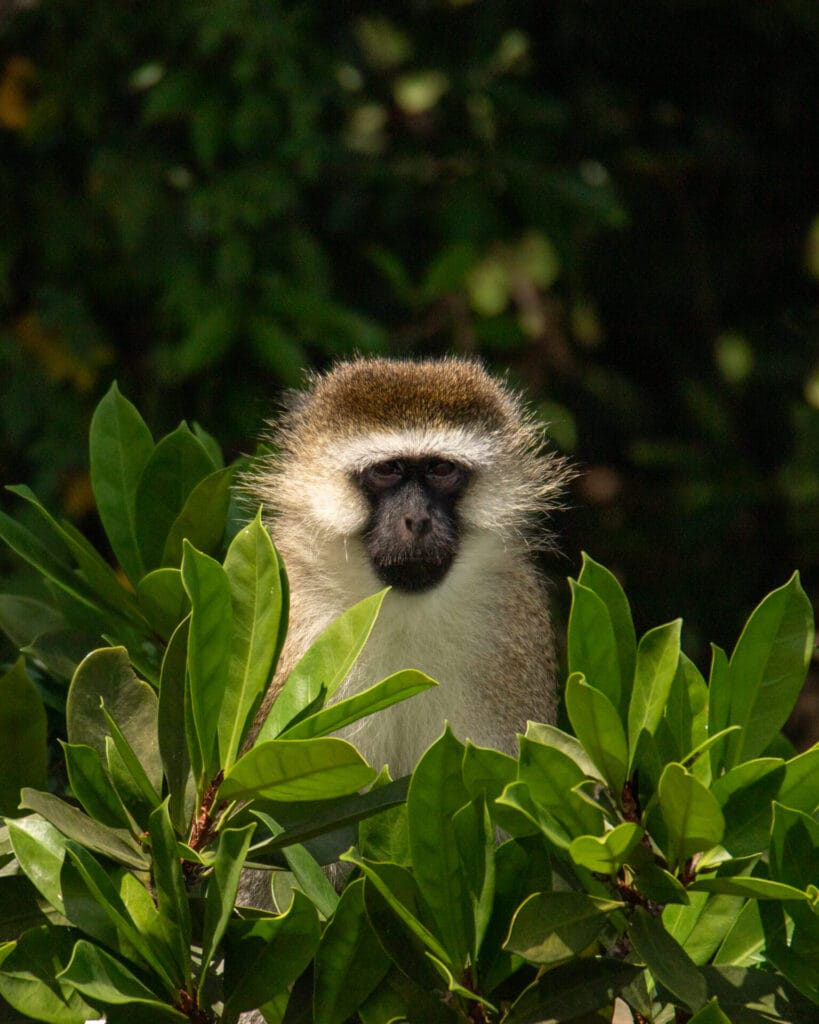





What to do in Kibuye
Arriving late on Day 6 and not departing until the afternoon of Day 8 gives you one full day and two leisurely half-days to explore Kibuye and surrounds— we found the southern end of Lake Kivu to be even more scenic and relaxing than the north (hence the allocation of 2 nights here).
- Boat trip to Napoleon Island: Cormoran Lodge (and most other accommodations on the lake) organise boat tours out to some of the surrounding islands and we specifically recommend the trip to Napoleon Island, where you’ll hike up a hill for panoramic views of the lake, visit a noisy bat colony, see an incredible variety of birdlife, and even some monkeys; we paid 40,000RWF ($28USD) total for a 2hr trip, but countless itineraries are available to see more of the lake!
- Visit a coffee plantation: the hills around Kibuye produce excellent coffee (in a country known for its coffee!), and many plantations offer informal tours and tastings, just ask at your accommodation
- Swim, paddle, or relax: the water here is clean and calm, perfect for a dip, a paddleboard session, or simply watching the sun set over the hills from your balcony!
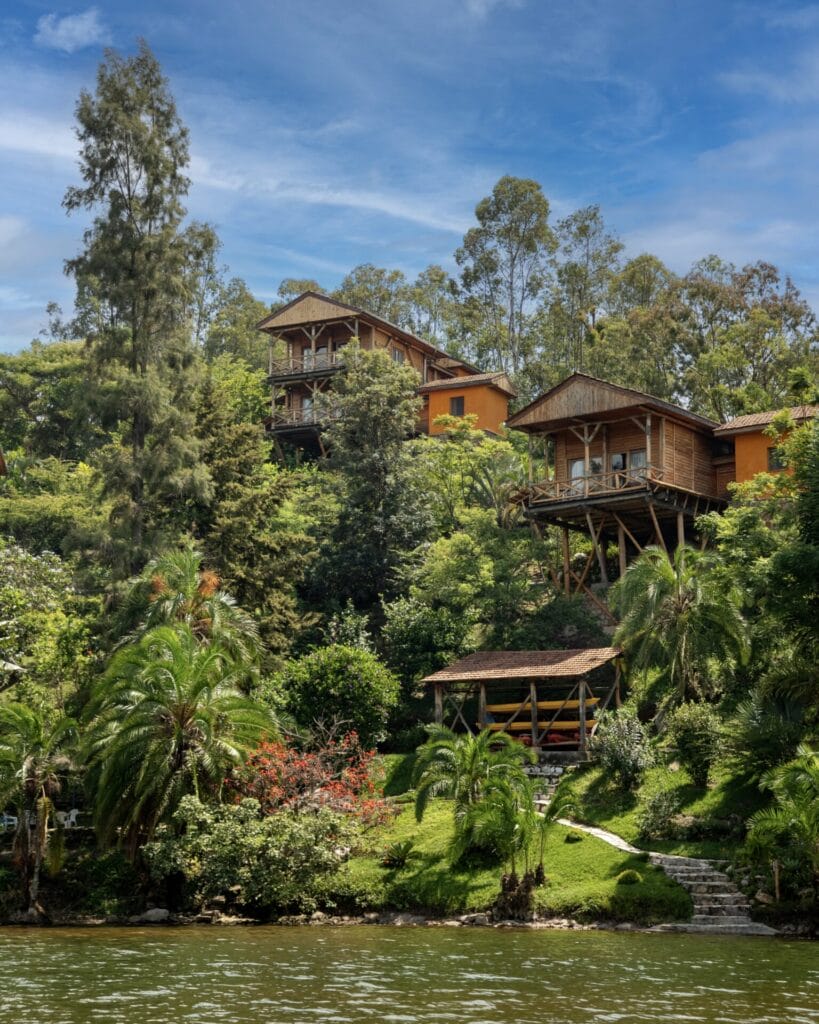
Where to stay in Kibuye
Our favourite place we stayed in all of Rwanda was Cormoran Lodge, a gorgeous lakeside retreat with just five wooden cabins, each perched on stilts above the water with private decks overlooking Lake Kivu. The views are next-level, the vibe is wonderfully serene, and the on-site restaurant serves great food and cold Mützig.
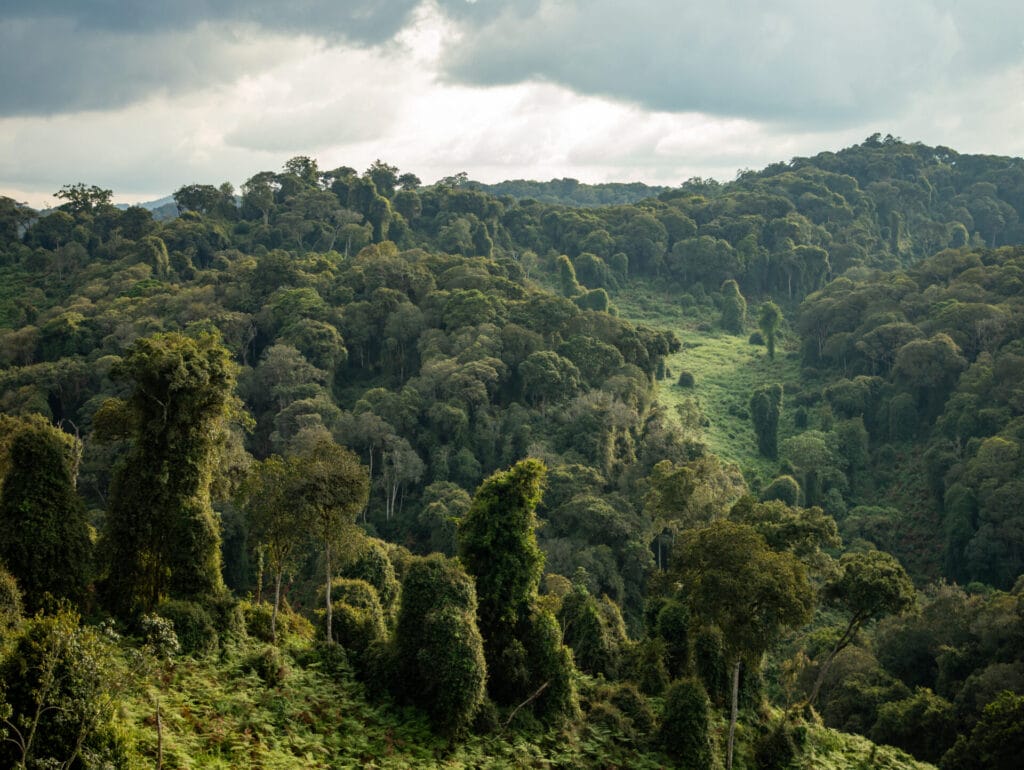
Days 8-9: Nyungwe National Park
From the shores of Lake Kivu, your road trip continues into the heart of Nyungwe National Park, a sprawling montane rainforest in Rwanda’s southwest that’s home to thirteen primate species, rare orchids, dense jungle trails, and the country’s most famous canopy walk. This is a gorgeous, richly biodiverse, and woefully under-visited national park that delivers the perfect full-day adventure (to make the most of that steep $100USD park entry)!
Getting to Nyungwe National Park
Departing Kibuye on the afternoon of Day 8, travel about 100km further south to the western edge of Nyungwe National Park. The drive takes about 2.5hrs and I’d recommend timing it so you arrive just before dark, since your only activity is eating dinner (at the guesthouse) and getting an early night ahead of chimpanzee trekking tomorrow!
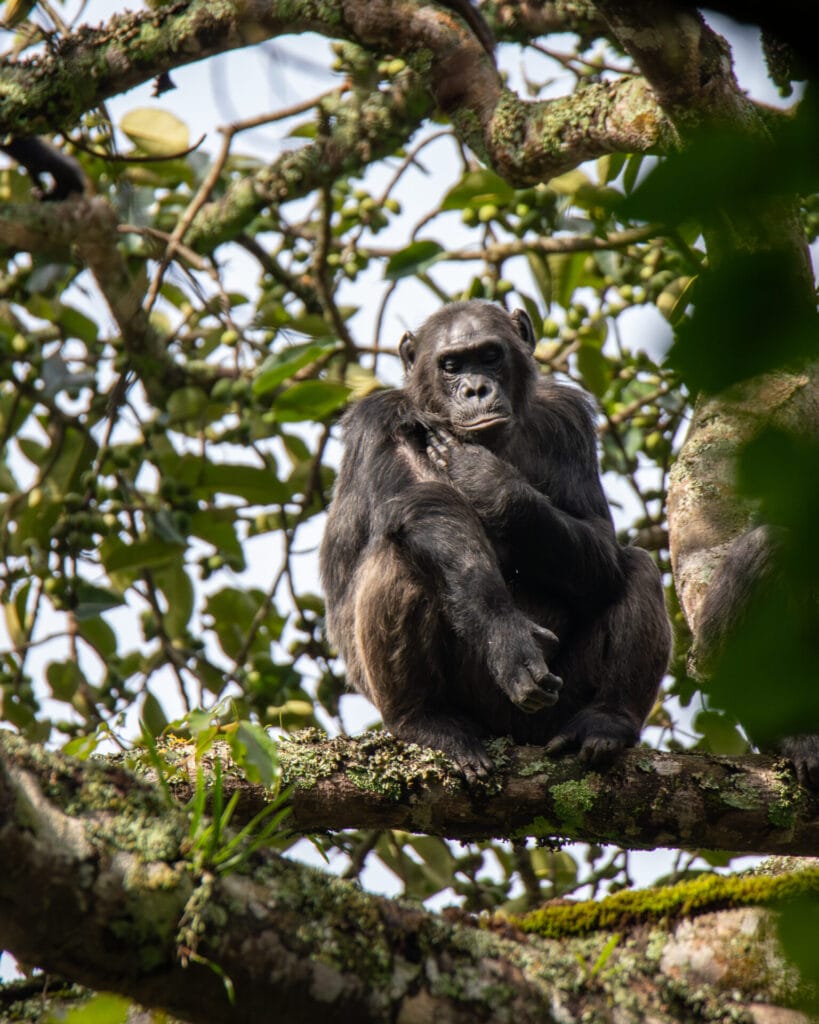
Chimpanzee trekking in Nyungwe National Park
On Day 9, set your alarm SUPER early for one of Rwanda’s most underrated wildlife experiences: chimpanzee trekking in Nyungwe National Park. It’s a completely different experience than gorilla trekking and the best thing to do in this densely forested park!
Nyungwe is home to two distinct chimpanzee communities:
- Nyungwe Forest, where a large group roams deep inside the national park
- Cyamudongo Forest, a small western annex of protected rainforest home to around 30 chimps
This itinerary works best for Cyamudongo Forest, and we absolutely loved the experience there. At just 4.2km², this section of the park is compact, making it much quicker to locate the chimps— and we had the entire experience to ourselves, with no other trekkers that day. It felt intimate, unfiltered, and incredibly special!
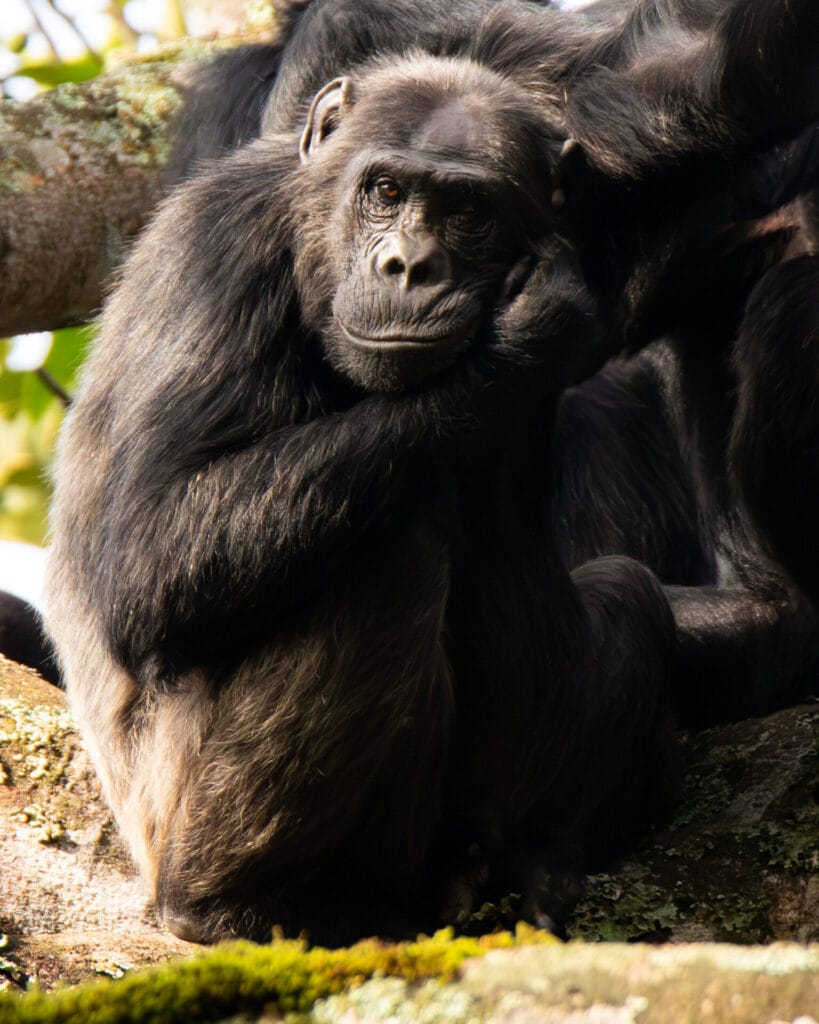
- Start time: confirmed at the time of booking, but expect to meet your guide around 5am (the meeting point is less than 10min from EAR Ken Barham Guesthouse, where we recommend staying on Night 8, but note that you and your guide will still need to drive 1.5-2hrs from here to reach the starting point for the trek in Cyamudongo Forest)
- Permit cost: $150 USD per person + $100 USD park entry; book by emailing nyungwe@africanparks.org
- Trek duration: typically 2-4hrs return, though it can be longer depending on chimp movement
- What to bring: rain jacket, sturdy hiking shoes, layers, water, and a camera!!
📸 Check out all the camera gear we use for travel & wildlife photography
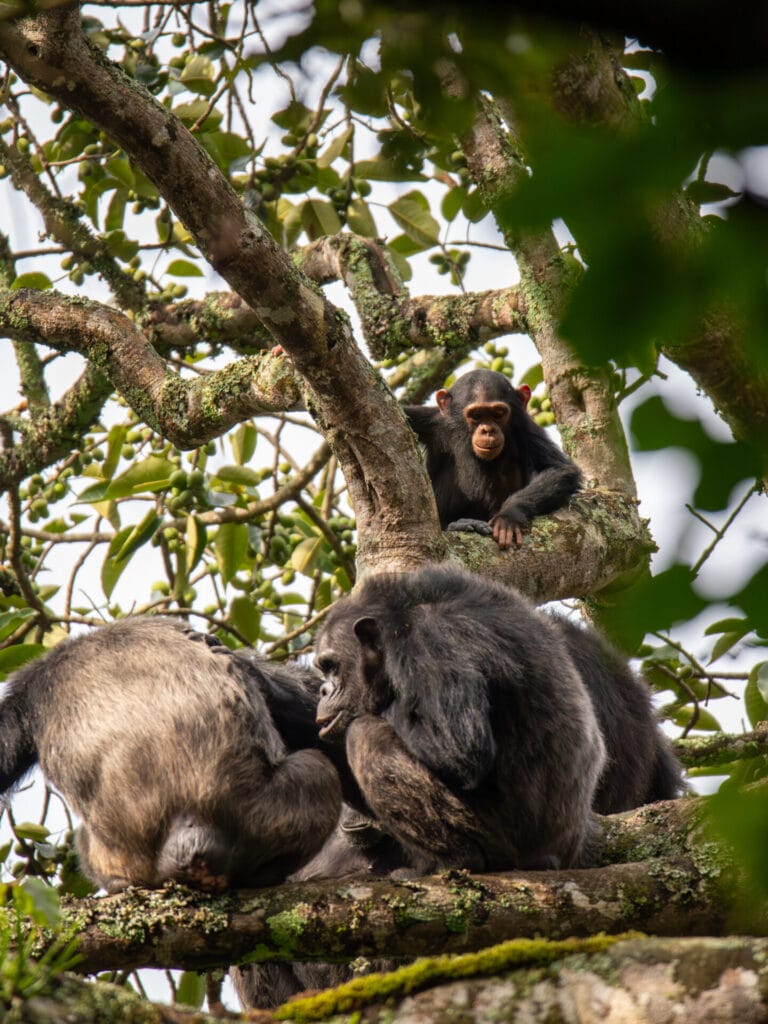
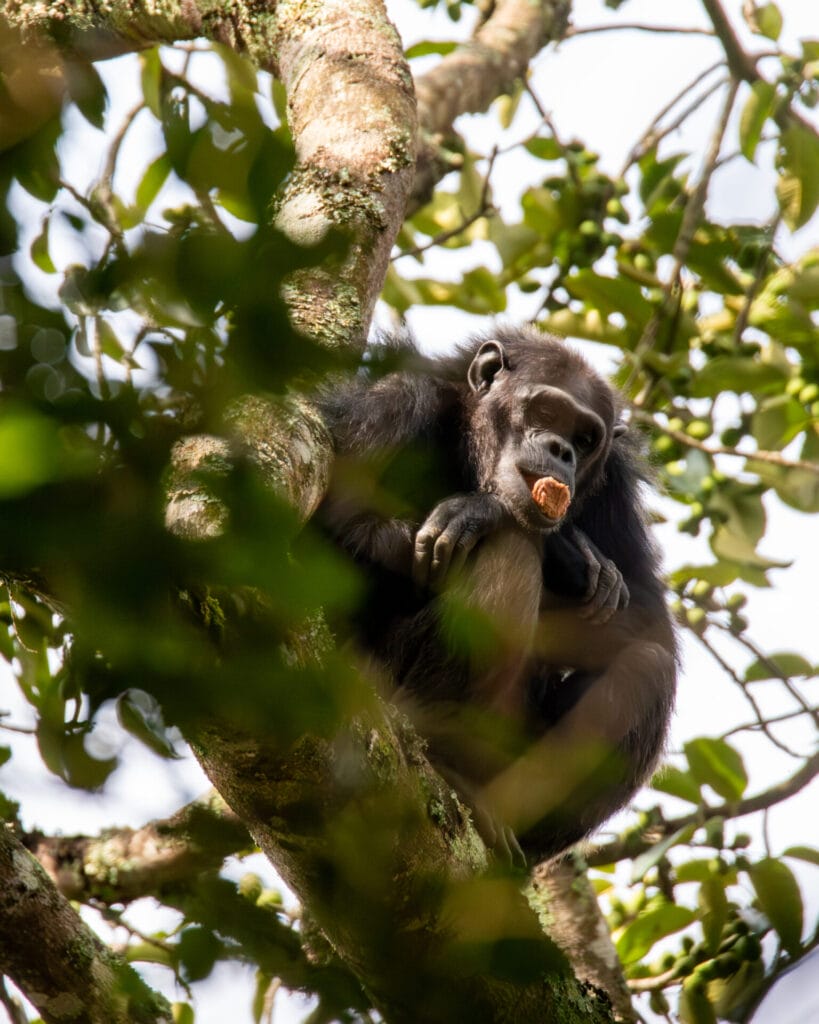
🦍 BEHIND THE SCENES: CHIMP TREKKING IN NYUNGWE
At Cyamudongo, a team of 5 full-time trackers work in shifts to monitor the chimps from dawn to dusk, ensuring that at least one person is with the family during their waking hours. It takes about 5 years of this quiet daily presence for the chimps to get used to the trackers and understand they aren’t a threat, and even longer for them to become habituated to mzungus (white people).
The trackers not only locate the chimps for visitors, but also collect important data on feeding habits, social dynamics, and movement patterns— playing a vital role in long-term conservation. Funds from your chimpanzee trekking permit directly support these efforts, and therefore tourism too plays an important role in habitat preservation, anti-poaching practices, and primate welfare.
Throughout the hike, your ranger is in constant communication with the trackers, who always know where the chimps are. Your success in seeing chimpanzees really only depends on whether you can hike far/fast enough to reach the group before they move again or whether you can keep up with them while they’re moving.
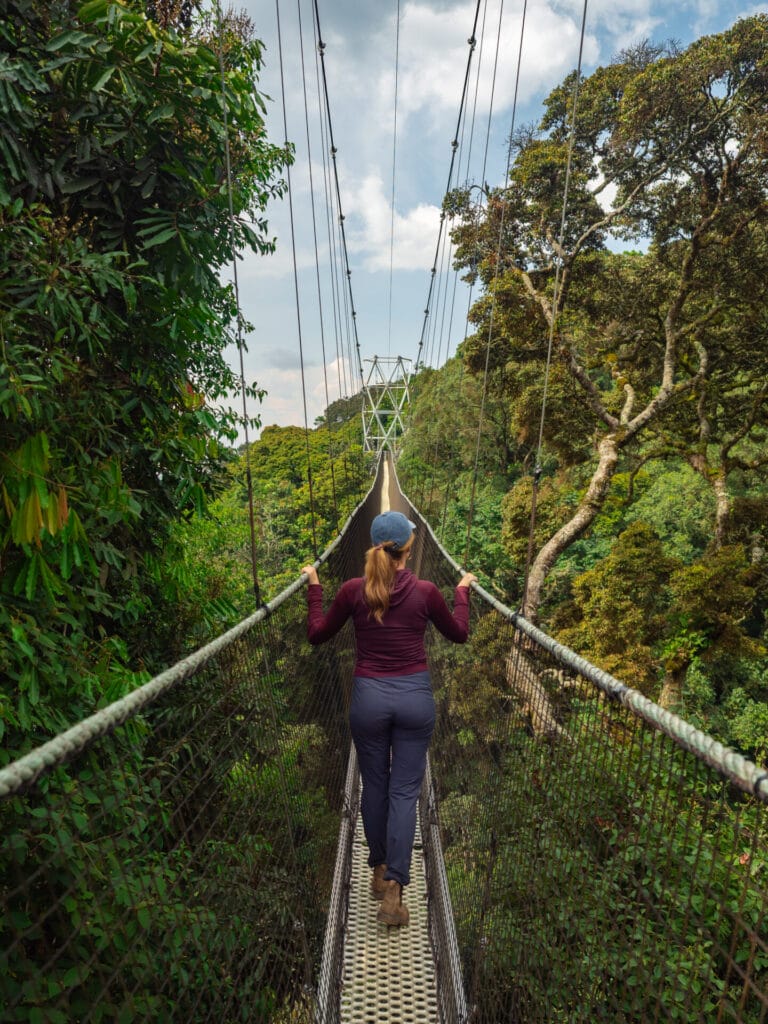
Canopy walk in Nyungwe National Park
After chimp trekking, continue east through the park for another highlight: the Nyungwe Canopy Walkway, a 90m-long suspension bridge hanging 50m above the forest floor.
You’ll need to join a guided group with a park ranger ($40USD), but it’s well worth it for the sweeping views across the treetops and a bird’s-eye perspective of Nyungwe’s dense green jungle. Plus, you already paid $100USD for park entry, so make the most of it!
The Canopy Walkway is accessed via the Igishigishigi Trail that begins at Uwinka Visitor Centre; we’d recommend driving here after chimp trekking, eating lunch at the on-site cafe, and then setting out with the ranger. Once again we were the only people here and enjoyed the experience entirely to ourselves, which made it even more enjoyable!
🌿 SCENIC DRIVE IN NYUNGWE NATIONAL PARK
The route through Nyungwe National Park on NR10 is incredibly scenic and full of wildlife: we saw golden monkeys, L’Hoest’s monkeys, duiker (a small antelope), olive baboons, Great Blue Turaco (amazing bird), and countless other fascinating species right off the side of the road!! Drive slowly, keep your eyes peeled, and you’ll undoubtedly see many amazing things in this wild forest.
*It’s also worth noting that, because Nyungwe Forest runs right up to the border with Burundi, there’s quite a large military presence here and you’ll see armed patrols every few kilometres alongside the road. I waved to every single soldier we passed and they always smiled and waved back, so don’t be alarmed, they are just here to watch the border!





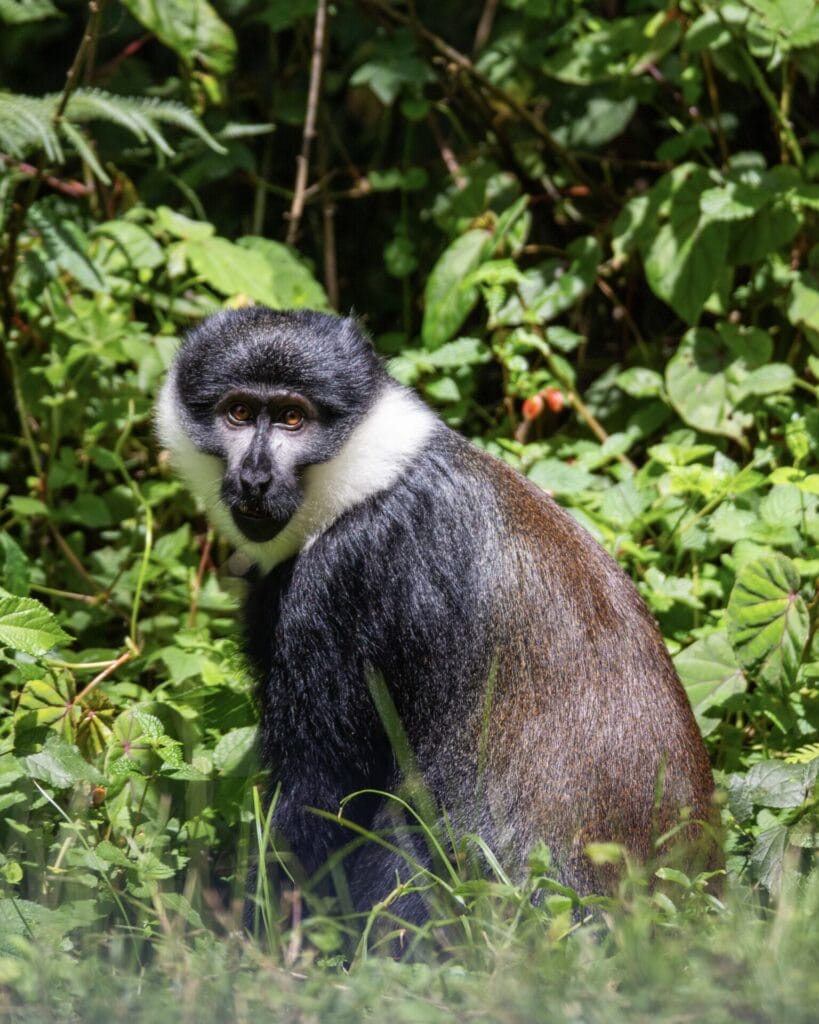
Where to stay near Nyungwe National Park
For this itinerary, you’ll want to stay 2 nights near Nyungwe National Park, but on different sides of this massive forest to cut down on travel time and unnecessary backtracking:
- Night 8: driving from Kibuye, stay on the west side of Nyungwe National Park at EAR Ken Barham Guesthouse in perfect position to drive to Cyamudongo and east through the park the following day. This is a simple but rather charming guesthouse— we were 2 of only 3 total guests and still (upon hearing there were mzungu in town) a local dance group came to put on an hour-long performance replete with traditional costumes, drum lines, and some of the cutest children we’ve ever seen, all of whom were SO excited to be out dancing and singing. Dinner is tasty and reasonably priced, and the staff packed our breakfast to-go so we could get on the road super early for chimpanzee trekking— hospitality was an 11/10!!
- Night 9: after driving the width of Nyungwe National Park, stay on the east side of the park at Kitabi Eco Centre, well-positioned to get back to the city tomorrow. Views over the rolling hills are fantastic from the outdoor patio, beer is cold (upon request— Rwandan’s typically prefer it warm, so you’ll have to specify), and the little huts are very rustic but fine for one night. Eat dinner and breakfast here for convenience.


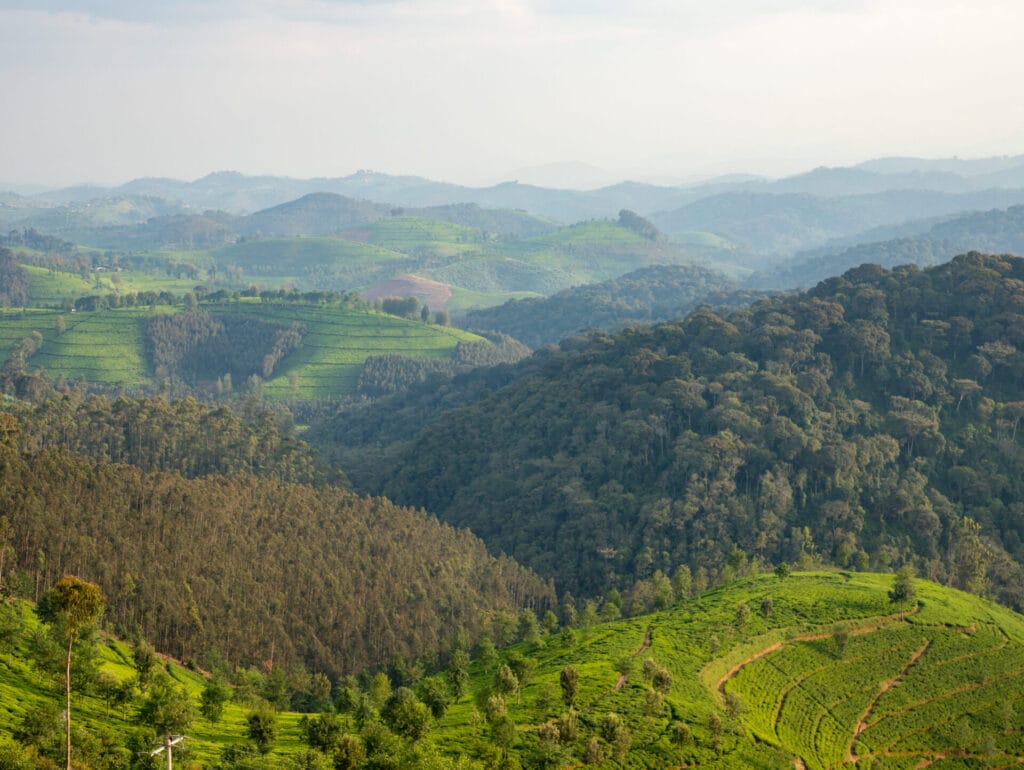
Day 10: return to Kigali
On your final day, make the scenic drive 180km northeast from Kitabi Eco Centre back to Kigali. The journey takes around 4.5 hours, though it’s worth leaving early to avoid traffic as you get closer to the capital. And just like that, your unforgettable 10-day road trip through the Land of a Thousand Hills comes to an end!
Rwanda itinerary extensions & modifications
- With 1-2 extra days? Add another night in Gisenyi at the north of Lake Kivu and/or another day in Volcanoes National Park to do golden monkey trekking!
- With 2 weeks? Visit Akagera National Park for a completely different ecosystem and the chance to spot lions, giraffes, and elephants on a classic savannah safari
- With 3 weeks? Combine this itinerary with a trip across the border to Uganda, visiting Bwindi Impenetrable Forest, Queen Elizabeth National Park, and Murchison Falls National Park— this is what we did and we had a phenomenal time!
Explore other adventure itineraries
2-week Patagonia itinerary: best of Torres del Paine & Los Glaciares/El Chaltén
10-day Rwanda road trip itinerary: gorilla trekking, volcanoes & Lake Kivu
